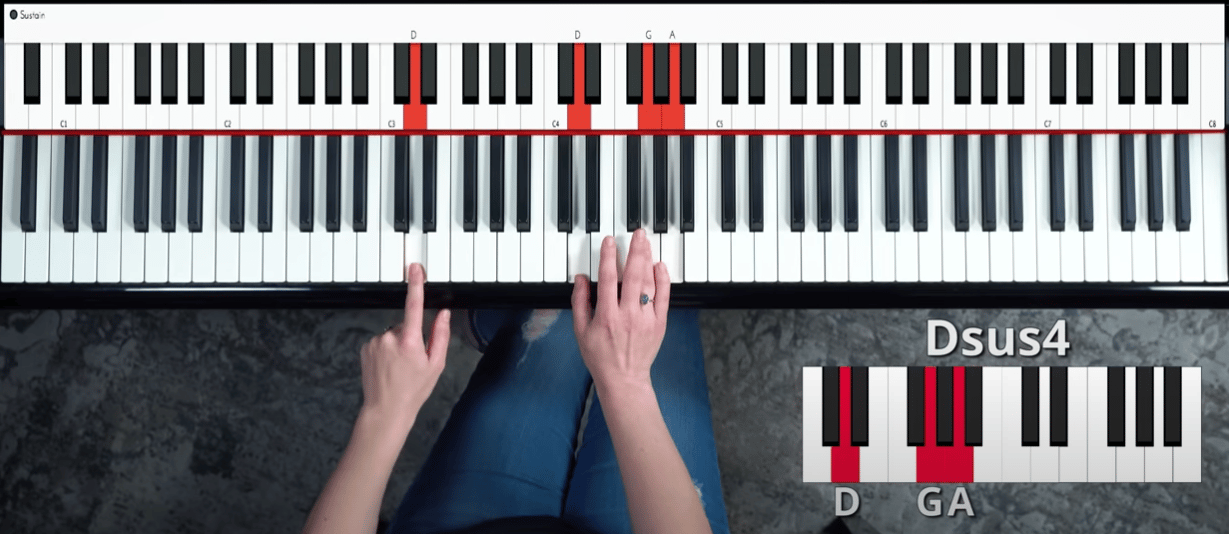A lot of people learn the piano because they want to play piano at church.
But the idea of playing in church can be daunting for any pianist, even if you’ve played before!
For one, you’re playing in front of people.
Sometimes a lot of people!
And most modern worship songs don’t even use sheet music. They use chord charts.
This was a big hurdle for me.
I remember my first time playing in church so vividly.
I was about 13 or 14 and had just joined the youth worship band. The band leader handed me a chord chart and said these words:
”When you see a chord, play the chord.”
That was it.
It was a steep learning curve for sure, and I don’t recommend this method for any new learners.
So that’s what today’s lesson is all about!
I want you to know that playing piano in church is NOT difficult, once you know the basics.
If you have the opportunity and even the slightest desire to play piano at church, you should try it.
As well as being a blessing and a gift for everyone else listening, there are some very practical reasons why it’s so good.
Playing at church will make you a better pianist and overall musician.
You’ll be learning new songs and new styles. You’ll likely have to play in some keys you’re not super familiar with.
And you’ll be playing in public with other musicians. There is really no better way to improve your skills quickly and develop your musical ear.
And finally, you’ll become a master of reading chord charts, which will set you up to play pretty much any modern worship or pop song you could ever want.
Like the ones in 500 Songs in 5 Days.
Almost all modern worship songs are presented on chord charts. Only hymns still use music from my experience.
A chord chart is simply the lyrics of the song with the chord names written above.
Here’s what I mean. Take a look at the the opening line of 10,000 Reasons:

You can see there are two letters above the lyrics, a C and a G. Those are the chords.
So when the singer sings “Lord”, that’s when you play a C.
The hardest thing about playing from chord charts is knowing when to change chords.
This is where listening to the song beforehand is so important. It’s so hard to play a song from a chord chart if you’ve never heard it before.
If you don’t know how to play chords, or you see a chord that you don’t recognize, don’t worry! There’s a formula you can use to play a major or minor chord from ANY note on the piano.
We won’t get into major and minor chords here. Click that lesson above if you’re not sure about them.
And you can choose whether you want to play these chords in root position, or experiment with inversions.
I do want to quickly mention a type of chord that is super common in worship music.
There will be a time when you’re playing along, enjoying the major and minor chords, when you’ll see this:

What?!
That is called a “sus” chord. It’s written on a chart by putting the letter name of the chord first, followed by the letters “sus” and then a number (4 or 2, but most often 4).
That 4 means you play the note that is 4 notes ABOVE the root note.
So for our D chord that will be a G. You can also think of it as 2 half-steps down from the top note of the chord.

Sus chords are most commonly followed by major chords, and that happens here. So you can see that right after we play the Dsus4 we play a D major chord.
So all you have to do is bump that G note down to F# to go back to the D major.
It creates a beautiful “resolving” sound.
If you see a “sus2” chord, like a Dsus2, then instead of playing the 4th note from the D scale you’d play the 2nd note, which is an E.
So your Dsus2 chord would have the notes D-E-A. It also sounds really pretty.
Playing piano at church is so much fun, and benefits so many people.
There’s the congregation, who will absolutely appreciate the music.
The Worship Pastor will be super grateful to have another member of the team.
And YOU will get so much out of it. From being able to express your faith through your musical abilities, and just from becoming a better musician and even making new friends.
I highly recommend it.
This lesson is a brief intro to show you that you CAN play piano at church.
We didn’t get too deep into the techniques. If you’re interested in learning more, we have a full training course specifically designed to equip you with the skills to join the worship team.
It’s called “Worship Piano” and you can learn more about it here (and see some previews of the lessons):
Good luck, and remember to have fun!
Subscribe to The Note for exclusive interviews, fascinating articles, and inspiring lessons delivered straight to your inbox. Unsubscribe at any time.
Lisa Witt has been teaching piano for more than 20 years and in that time has helped hundreds of students learn to play the songs they love. Lisa received classical piano training through the Royal Conservatory of Music, but she has since embraced popular music and playing by ear in order to accompany herself and others. Learn more about Lisa.
/marketing/pianote/lead-gen/getting-started/coach.webp)
/marketing/pianote/lead-gen/getting-started/logo.webp)
By signing up you’ll also receive our ongoing free lessons and special offers. Don’t worry, we value your privacy and you can unsubscribe at any time.
We use cookies for traffic data and advertising. Cookie Policy »